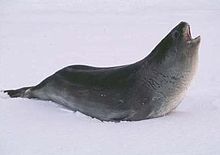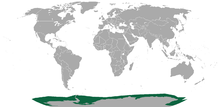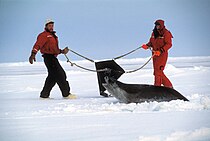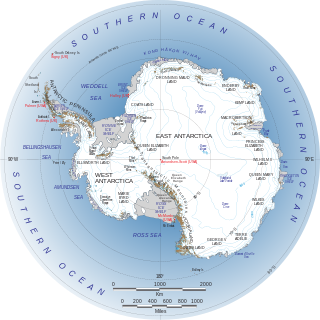
The earless seals, phocids, or true seals are one of the three main groups of mammals within the seal lineage, Pinnipedia. All true seals are members of the family Phocidae. They are sometimes called crawling seals to distinguish them from the fur seals and sea lions of the family Otariidae. Seals live in the oceans of both hemispheres and, with the exception of the more tropical monk seals, are mostly confined to polar, subpolar, and temperate climates. The Baikal seal is the only species of exclusively freshwater seal.

Pinnipeds, commonly known as seals, are a widely distributed and diverse clade of carnivorous, fin-footed, semi-aquatic, and mostly marine mammals. They comprise the extant families Odobenidae, Otariidae, and Phocidae, with 34 extant species and more than 50 extinct species described from fossils. While seals were historically thought to have descended from two ancestral lines, molecular evidence supports them as a monophyletic lineage. Pinnipeds belong to the clade Caniformia of the order Carnivora; their closest living relatives are musteloids, having diverged about 50 million years ago.
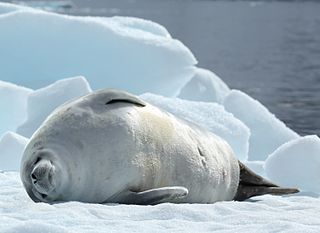
The crabeater seal, also known as the krill-eater seal, is a true seal with a circumpolar distribution around the coast of Antarctica. They are medium- to large-sized, relatively slender and pale-colored, found primarily on the free-floating pack ice that extends seasonally out from the Antarctic coast, which they use as a platform for resting, mating, social aggregation and accessing their prey. They are by far the most abundant seal species in the world. While population estimates are uncertain, there are at least 7 million and possibly as many as 75 million individuals. This success of this species is due to its specialized predation on the abundant Antarctic krill of the Southern Ocean, for which it has uniquely adapted, sieve-like tooth structure. Indeed, its scientific name, translated as "lobe-toothed (lobodon) crab eater (carcinophaga)", refers specifically to the finely lobed teeth adapted to filtering their small crustacean prey. Despite its name, crabeater seals do not eat crabs. As well as being an important krill predator, the crabeater seal's pups are an important component of the diet of leopard seals. They are the only member of the genus Lobodon.

The bearded seal, also called the square flipper seal, is a medium-sized pinniped that is found in and near to the Arctic Ocean. It gets its generic name from two Greek words that refer to its heavy jaw. The other part of its Linnaean name means bearded and refers to its most characteristic feature, the conspicuous and very abundant whiskers. When dry, these whiskers curl very elegantly, giving the bearded seal a "raffish" look.

The leopard seal, also referred to as the sea leopard, is the second largest species of seal in the Antarctic. Its only natural predator is the orca. It feeds on a wide range of prey including cephalopods, other pinnipeds, krill, fish, and birds, particularly penguins. It is the only species in the genus Hydrurga. Its closest relatives are the Ross seal, the crabeater seal and the Weddell seal, which together are known as the tribe of Lobodontini seals. The name hydrurga means "water worker" and leptonyx is the Greek for "thin-clawed".
The Convention for the Conservation of Antarctic Seals (CCAS) is part of the Antarctic Treaty System. It was signed at the conclusion of a multilateral conference in London on February 11, 1972.

The Antarctic fur seal, is one of eight seals in the genus Arctocephalus, and one of nine fur seals in the subfamily Arctocephalinae. Despite what its name suggests, the Antarctic fur seal is mostly distributed in Subantarctic islands and its scientific name is thought to have come from the German vessel SMS Gazelle, which was the first to collect specimens of this species from Kerguelen Islands.

The Weddell seal is a relatively large and abundant true seal with a circumpolar distribution surrounding Antarctica. The Weddell seal was discovered and named in the 1820s during expeditions led by British sealing captain James Weddell to the area of the Southern Ocean now known as the Weddell Sea. The life history of this species is well documented since it occupies fast ice environments close to the Antarctic continent and often adjacent to Antarctic bases. It is the only species in the genus Leptonychotes.

The ribbon seal is a medium-sized pinniped from the true seal family (Phocidae). A seasonally ice-bound species, it is found in the Arctic and Subarctic regions of the North Pacific Ocean, notably in the Bering Sea and Sea of Okhotsk. It is distinguished by its striking coloration, with two wide white strips and two white circles against dark brown or black fur.
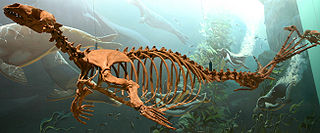
Acrophoca longirostris, sometimes called the swan-necked seal, is an extinct genus of Late Miocene pinniped. It was thought to have been the ancestor of the modern leopard seal; however, it is now thought to be a species of monk seal.
Ice seal, or pack-ice seal is a general term applied to any one of a number of pinniped species of the family Phocidae whose life cycle is completed largely on or about the sea ice of the Earth's polar regions.

Hauling-out is a behaviour associated with pinnipeds temporarily leaving the water. Hauling-out typically occurs between periods of foraging activity. Rather than remain in the water, pinnipeds haul-out onto land or sea-ice for reasons such as reproduction and rest. Hauling-out is necessary in seals for mating and giving birth. Other benefits of hauling-out may include predator avoidance, thermoregulation, social activity, parasite reduction and rest.

The true seal tribe Lobodontini, collectively known as the Antarctic seals or lobodontin seals, consist of four species of seals in four genera: the crabeater seal, the leopard seal, the Weddell seal, and the Ross seal. All lobodontine seals have circumpolar distributions surrounding Antarctica. They include both the world's most abundant seal and the only predominantly mammal-eating seal. While the Weddell seal prefers the shore-fast ice, the other species live primarily on and around the off-shore pack ice. Thus, though they are collectively the most abundant group of seals in the world, the combination of remote range and inaccessible habitat make them among the least well studied of the world's seals.

The wildlife of Antarctica are extremophiles, having adapted to the dryness, low temperatures, and high exposure common in Antarctica. The extreme weather of the interior contrasts to the relatively mild conditions on the Antarctic Peninsula and the subantarctic islands, which have warmer temperatures and more liquid water. Much of the ocean around the mainland is covered by sea ice. The oceans themselves are a more stable environment for life, both in the water column and on the seabed.
Homiphoca is an extinct genus of earless seals from the Pliocene of South Africa.

Monachinae is a subfamily of Phocidae whose distribution is found in the tropical, temperate and polar regions of the southern hemisphere, though in the distant past fossil representatives have been found on both sides of the North Atlantic Ocean. The difference between members of this group and members of Phocinae is in monachines the hindclaws are greatly reduced in size. Furthermore, all species have 34 chromosomes. There are three tribes recognized here: Monachini, Miroungini, and Lobodontini. While today represented by eight extant and one recently extinct species, Monachinae had an incredibly enriched fossil diversity that went into decline soon to be replaced by southern species of sea lions and fur seals.
